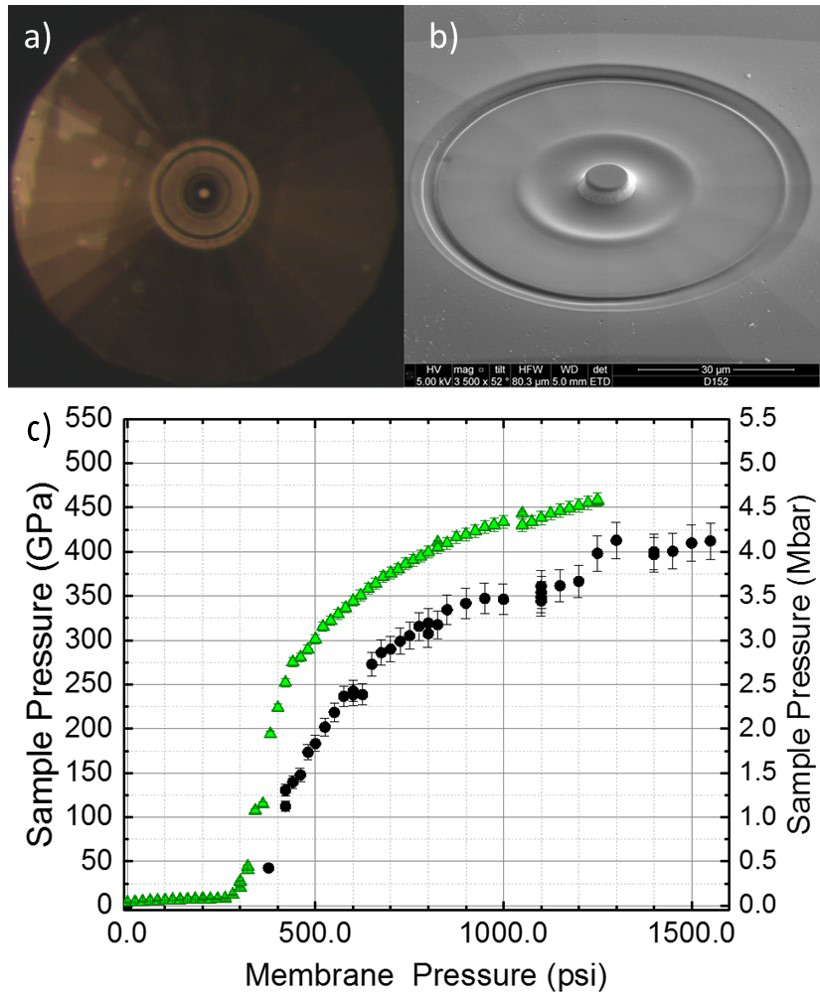Zsolt Jenei (17-ERD-038)
Executive Summary
Our goal is to provide high-accuracy equation-of-state data for metals over an unprecedented range of pressures under static compression using newly designed diamond anvil cells. We are probing new physics in this regime of extreme conditions and developing new experiment-based understandings of the physics driving material transitions, which supports missions in nuclear stockpile stewardship.
Project Description
The equation of state (EOS) is of fundamental importance in high-pressure science. The EOS relates pressure to the volume, density, and temperature of a material in a given equilibrium condition. The relationship is a reflection of the chemical bonding and electronic structure of the materials. Discontinuities in the equation of state—changes in the compressibility—are indicative of changes in structural properties of materials. In the development of accurate equations of state, the isothermal pressure–volume curves are one of the most important constraints. In addition, phase transition can have a strong effect on compressibility, transport properties, and other constitutive properties that are necessary to model the properties of materials under extreme conditions and to develop accurate high pressure and temperature equations of state. Until recently, static high-pressure experimental data have been limited to about 350 GPa and, on a very rare occasion, to 420 GPa. We are investigating phase transitions in metals (magnesium, aluminum, and vanadium) at ultrahigh pressures of 300 to 700 GPa and establishing a capability to routinely achieve these high pressures well beyond the range of conventional static high-pressure techniques. We are probing new physics in this regime of extreme conditions and developing new experiment-based understandings of the physics driving the transitions. We plan to reach greater than 5-Mbar pressure using diamond anvil cells with new diamond designs that we are currently studying. Diamond anvil cell studies very accurately determine the structure and the thermodynamic state variable of temperature. Extending diamond anvil cell diffraction to more than double the current conventional pressure range will provide high-fidelity equations of state at highly accurate pressure and temperature conditions to complement measurements from other platforms such as lasers, gas guns, and pulsed power. We will use third-generation synchrotron x-ray sources to collect x-ray diffraction patterns to determine the crystal structures, lattice parameters, and phase-transition pressures of the materials, and their isothermal equations of state.
We expect to provide high-accuracy equation-of-state data over an unprecedented range of pressure under static compression, exceeding the previous pressure range of a single-stage diamond anvil cell by more than 300 GPa. Establishing this capability at Livermore will enable investigations of scientific, technological, and programmatic materials in an entirely new regime, and will complement dynamic drive experiments. At temperatures beyond ambient, equations of state of metals can be employed in studying planetary materials in Earth and super-Earth-like conditions. We plan to reach high-pressure conditions of more than 6 Mbar with static compression using diamond anvil cells with new diamond designs. The new diamond anvils have a toroidally structured tip with an 8- to 15-µm central flat sculpted on a diamond anvil using Livermore's focused ion-beam facility. This is expected to double the accessible pressure range of diamond anvil cells. Previous experiments with toroidal designs have demonstrated this enhanced performance. We will use micro-focused, third-generation synchrotron x-ray sources to collect powder x-ray diffraction patterns of materials to determine their crystal structures, lattice constants, and phase-transition pressures. Our aim for the first year is to experimentally establish the ambient temperature compression curve of vanadium to at least 500 GPa. We will then extend the ambient temperature compression curve of magnesium and aluminum to beyond 600 GPa, while continuing our efforts to increase the high-pressure limits of static compression experiments. Finally, we will focus our experiments on establishing high pressure and temperature stability of the high-pressure phases by determining the phase-transition pressure dependence as a function of temperature.
Mission Relevance
Our work supports stockpile stewardship science and the Laboratory's high-energy-density science core competency by maintaining Livermore capabilities at the leading edge of static high-pressure science, and providing validated tools for measurement of programmatically important materials. A capability of achieving pressures greater than 5 Mbar while incorporating the fidelity of diamond anvil cells would be a significant capability for future programmatic applications, and is relevant to DOE goals in science and energy as well as nuclear security.
FY17 Accomplishments and Results
In FY17 we (1) expanded the pressure range of the diamond anvil cell by refining the anvil tip geometry so that it reliably reaches nearly 500 GPa, (2) performed an ambient-temperature compression experiment on vanadium to above 300 GPa, (3) began to develop advanced sample-loading mechanisms to enhance the mechanical stability of the sample in the center of the anvil culets (tips compressing the sample), and (4) worked to complete the phase-stability study of vanadium.
   






